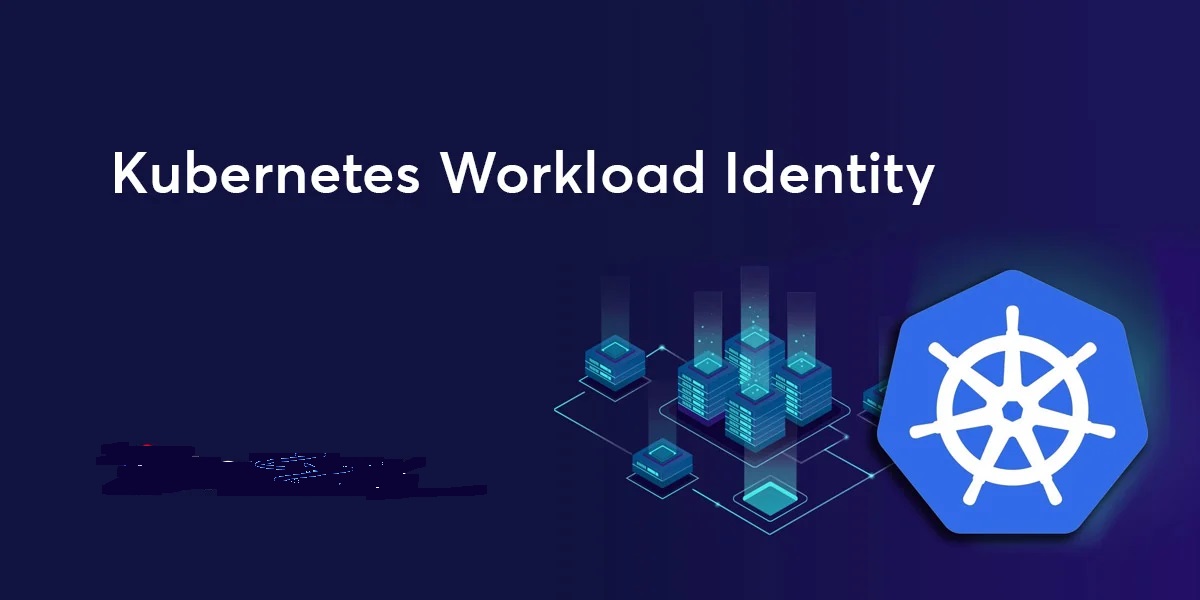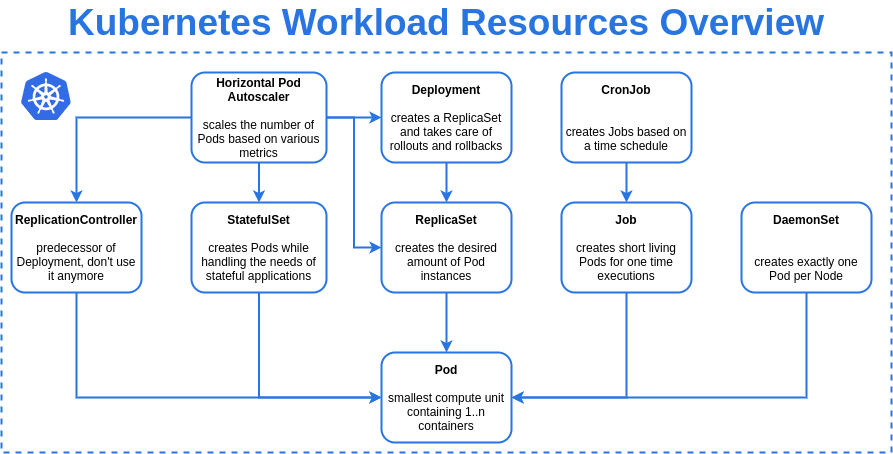#KubeWeek Challenge Day-3 Kubernetes Workloads (Deployments, Jobs, CronJobs, etc.)
 Santosh Chauhan
Santosh Chauhan
Kubernetes Workloads:
Kubernetes workloads are divided into two major components: pods (the basic building block) and controllers (e.g. ReplicaSet, Deployment, StatefulSet, CronJob, etc.).

Pods:
A Pod for Kubernetes is what a container is for Docker: the smallest and simplest unit in its object model. It's helpful to conceptualize Pods as a single instance of an application—or a container. In reality, a Pod encapsulates one or more containers as well as storage resources, an IP address, and rules on how the container(s) should run.
Use Cases for Different Types of Workload Resources:
| Workload Resource | Common Use Cases |
| Deployment and ReplicaSet | A Deployment provides declarative updates for Pods and ReplicaSets. You describe a desired state in a Deployment, and the Deployment Controller changes the actual state to the desired state at a controlled rate. You can define Deployments to create new ReplicaSets, or to remove existing Deployments and adopt all their resources with new Deployments. A ReplicaSet's purpose is to maintain a stable set of replica Pods running at any given time. As such, it is often used to guarantee the availability of a specified number of identical Pods. |
| StatefulSet | As the name implies, StatefulSets are often used for stateful applications. StatefulSets can also be used for highly available applications and applications that need multiple pods and server leaders. For example, a highly available RabbitMQ messaging service. |
| DaemonSet | DaemonSets are often used for log collection or node monitoring. For example, the Elasticsearch, Fluentd, and Kibana (EFK) stack can be used for log collection. |
| Job and CronJob | CronJobs and Jobs are used to run pods that only need to run at specific times, such as creating a database backup. A CronJob creates Jobs on a repeating schedule. |
| Custom Resource | Custom resources are often used for multiple purposes, such as top-level kubectl support or adding Kubernetes libraries and CLIs to create and update new resources. An example of a new resource is a Certificate Manager, which enables HTTPS and TLS support. |
Creating a Deployment:
The following is an example of a Deployment. It creates a ReplicaSet to bring up three nginx Pods:
apiVersion: apps/v1
kind: Deployment
metadata:
name: nginx-deployment
labels:
app: nginx
spec:
replicas: 3
selector:
matchLabels:
app: nginx
template:
metadata:
labels:
app: nginx
spec:
containers:
- name: nginx
image: nginx:1.14.2
ports:
- containerPort: 80
ReplicaSet :
ensures that a specified number of pod replicas are running at any given time.
apiVersion: apps/v1
kind: ReplicaSet
metadata:
name: frontend
labels:
app: guestbook
tier: frontend
spec:
# modify replicas according to your case
replicas: 3
selector:
matchLabels:
tier: frontend
template:
metadata:
labels:
tier: frontend
spec:
containers:
- name: php-redis
image: gcr.io/google_samples/gb-frontend:v3
Saving this manifest into frontend.yaml and submitting it to a Kubernetes cluster will create the defined ReplicaSet and the Pods that it manages.
Components of a StatefulSet:
The example below demonstrates the components of a StatefulSet.
apiVersion: v1
kind: Service
metadata:
name: nginx
labels:
app: nginx
spec:
ports:
- port: 80
name: web
clusterIP: None
selector:
app: nginx
---
apiVersion: apps/v1
kind: StatefulSet
metadata:
name: web
spec:
selector:
matchLabels:
app: nginx # has to match .spec.template.metadata.labels
serviceName: "nginx"
replicas: 3 # by default is 1
minReadySeconds: 10 # by default is 0
template:
metadata:
labels:
app: nginx # has to match .spec.selector.matchLabels
spec:
terminationGracePeriodSeconds: 10
containers:
- name: nginx
image: registry.k8s.io/nginx-slim:0.8
ports:
- containerPort: 80
name: web
volumeMounts:
- name: www
mountPath: /usr/share/nginx/html
volumeClaimTemplates:
- metadata:
name: www
spec:
accessModes: [ "ReadWriteOnce" ]
storageClassName: "my-storage-class"
resources:
requests:
storage: 1Gi
Create a DaemonSet:
You can describe a DaemonSet in a YAML file. For example, the daemonset.yaml file below describes a DaemonSet that runs the fluentd-elasticsearch Docker image:
apiVersion: apps/v1
kind: DaemonSet
metadata:
name: fluentd-elasticsearch
namespace: kube-system
labels:
k8s-app: fluentd-logging
spec:
selector:
matchLabels:
name: fluentd-elasticsearch
template:
metadata:
labels:
name: fluentd-elasticsearch
spec:
tolerations:
# these tolerations are to have the daemonset runnable on control plane nodes
# remove them if your control plane nodes should not run pods
- key: node-role.kubernetes.io/control-plane
operator: Exists
effect: NoSchedule
- key: node-role.kubernetes.io/master
operator: Exists
effect: NoSchedule
containers:
- name: fluentd-elasticsearch
image: quay.io/fluentd_elasticsearch/fluentd:v2.5.2
resources:
limits:
memory: 200Mi
requests:
cpu: 100m
memory: 200Mi
volumeMounts:
- name: varlog
mountPath: /var/log
terminationGracePeriodSeconds: 30
volumes:
- name: varlog
hostPath:
path: /var/log
Running an example Job:
Here is an example Job config. It computes π to 2000 places and prints it out. It takes around 10s to complete.
apiVersion: batch/v1
kind: Job
metadata:
name: pi
spec:
template:
spec:
containers:
- name: pi
image: perl:5.34.0
command: ["perl", "-Mbignum=bpi", "-wle", "print bpi(2000)"]
restartPolicy: Never
backoffLimit: 4
Cronjob Example:
This example CronJob manifest prints the current time and a hello message every minute:
apiVersion: batch/v1
kind: CronJob
metadata:
name: hello
spec:
schedule: "* * * * *"
jobTemplate:
spec:
template:
spec:
containers:
- name: hello
image: busybox:1.28
imagePullPolicy: IfNotPresent
command:
- /bin/sh
- -c
- date; echo Hello from the Kubernetes cluster
restartPolicy: OnFailure
Thank you for reading!Happy Learning!!
Santosh Chauhan
Subscribe to my newsletter
Read articles from Santosh Chauhan directly inside your inbox. Subscribe to the newsletter, and don't miss out.
Written by

Santosh Chauhan
Santosh Chauhan
Hello, I'm Santosh Chauhan, a DevOps enthusiast, who enjoys automation, continuous integration, and deployment. With extensive Hands-on experience in DevOps and Cloud Computing, I am proficient in various tools and technologies related to infrastructure automation, containerization, cloud platforms, monitoring and logging, and CI/CD. My ultimate objective is to assist organizations in achieving quicker, more effective software delivery while maintaining high levels of quality and dependability.